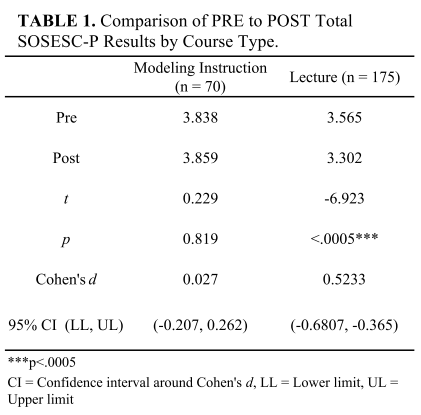Developed by Heidi Fencl and Karen Scheel
| Purpose | To assess students’ beliefs that they can succeed in their physics course. |
|---|---|
| Format | Pre/post, Multiple-choice, Agree/disagree |
| Duration | 20 min |
| Focus | Beliefs / Attitudes (self-efficacy) |
| Level | Intro college |
Sample statements from the SOSESC-P:
I am capable of receiving good grades on my assignments in this class.
1 Strongly disagree 2 Disagree 3 Neutral 4 Agree 5 Strongly agree
Listening to the instructor and other students in question-and-answer sessions makes me think that I cannot understand physics.
1 Strongly disagree 2 Disagree 3 Neutral 4 Agree 5 Strongly agree
I get positive feedback about my ability to recall physics ideas.
1 Strongly disagree 2 Disagree 3 Neutral 4 Agree 5 Strongly agree
Everything you need to know about implementing the SOSESC-P in your class.
more details
This is the third highest level of research validation, corresponding to at least 3 of the validation categories below.
Research Validation Summary
Based on Research Into:
- Student thinking
Studied Using:
- Student interviews
- Expert review
- Appropriate statistical analysis
Research Conducted:
- At multiple institutions
- By multiple research groups
- Peer-reviewed publication
A portion of the Likert-scale questions on the SOSESC were taken from existing math and general academic surveys of self-efficacy. Additional new questions were written based on the developers experience with undergraduate science education. The SOSESC was given to over 600 undergraduates, and appropriate analysis of validity and reliability was conducted. A confirmatory factor analysis was performed to ensure the four categories of questions were aligned with the way students thought about the questions. The SOSESC has been given to over 1100 students at several universities and the results published in three peer-reviewed publications.
References
- H. Fencl and K. Scheel, Research and Teaching: Engaging Students - An Examination of the Effects of Teaching Strategies on Self-Efficacy and Course Climate in a Nonmajors Physics Course, J. Coll. Sci. Teaching 35 (1), 20 (2005).
- V. Sawtelle, E. Brewe, and L. Kramer, Positive Impacts of Modeling Instruction on Self-Efficacy, presented at the Physics Education Research Conference 2010, Portland, Oregon, 2010.
We don't have any translations of this assessment yet.
If you know of a translation that we don't have yet, or if you would like to translate this assessment, please contact us!
Download the SOSESC-P answer key.
| Typical Results |
|---|
Typical scores on the SOSESC-P from Sawtelle, Brewe and Kramer, 2010.
Typical Results from Fencl and Scheel, 2004: |
The latest version of the SOSESC-P, released in 2004, is version 1. The SOSESC has been adapted for several disciplines including physics and chemistry.





